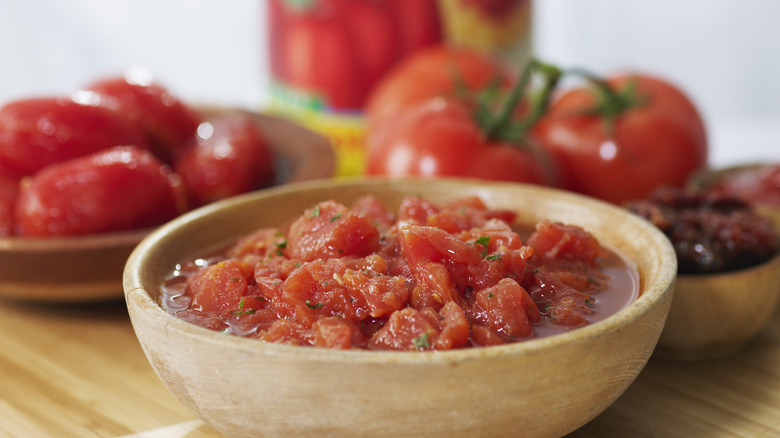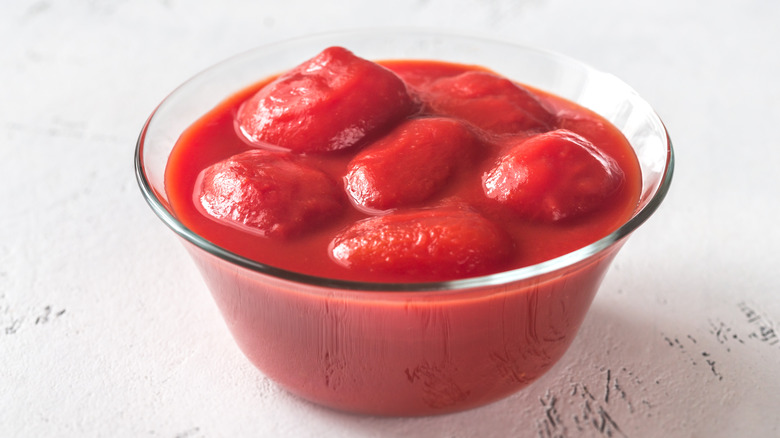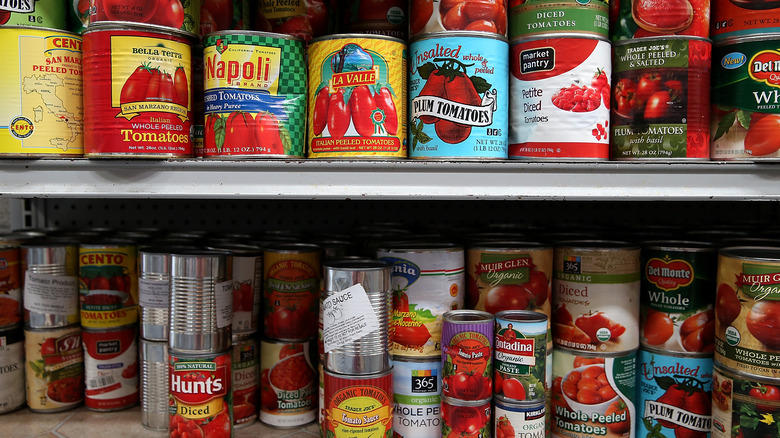The Difference Between Roma And San Marzano Canned Tomatoes
Want to make the most magical marinara? The first (and most important) step is choosing the right tomatoes.
You can make great tomato sauce from both fresh and canned tomatoes — just be sure to keep seasonality in mind when you're deciding. But most of the time, canned tomatoes are your best bet. They're harvested at the peak of ripeness and canned fresh to lock in their flavors. No matter if your fruit is canned or fresh, however, experts agree that the best sauce-making tomatoes are the elongated ones, which are plum or paste tomatoes, according to Slate. And the king of all paste tomatoes is the prized San Marzano. While these tomatoes can taste bland when eaten fresh, they turn into silky, smooth, flavorful sauce when they're cooked.
That should make choosing the best tomatoes easy, right? Just head to the grocery store and grab a can of any of the tomatoes on the shelf labeled "San Marzano." Well, not so fast. For starters, all San Marzano tomatoes are plum tomatoes, but not all plum tomatoes are San Marzanos. The majority of the canned tomatoes in the United States are actually Roma tomatoes, which aren't the same. It's easy to figure out which can is which, however, if you know what you're looking for.
What's in a name?
So you're in the canned vegetable aisle. Now what? First off, just because the label says the words "San Marzano," that doesn't necessarily mean the tomatoes are from Italy. If you look a little closer at most of the labels, you will often read "San Marzano style." What gives?
San Marzano tomatoes are like Champagne — they must grow in a specific locale to be the real deal. In this case, according to The New York Times, the tomatoes need to be grown in the Agro Nocerino-Sarnese region of Italy, in accordance with Italian law. The plum tomatoes grown in this region are protected by the Italian Denominazione d' Origine Protetta (D.O.P), which translated is protected designation of origin. This means that the region is registered with the European Community to indicate a high-quality Italian product (per Assolatte). So, you can grow a genetically-identical San Marzano tomato anywhere you want, but you can't legally sell it as a San Marzano — you can only call it "San Marzano style."
And what about Romas? Slate explains that after the San Marzano tomato's commercial introduction in the 1920s, plant breeders tinkered with tomato varieties to find a fruit that was similar in taste and structure to San Marzanos, but more resistant to disease and rot, and easier to harvest with machines. They eventually came up with Roma tomatoes in the 1950s, which are a cross of San Marzano with two other varieties (one of which is also a San Marzano cross).
Don't be fooled
Unfortunately, even an eagle-eyed shopper can sometimes be fooled into buying phony San Marzano tomatoes. As The New York Times reports, this is because falsely-labeled tomatoes are a big business. And Food & Wine says the majority of canned San Marzanos in the United States are fake.
If you want a better chance at sourcing true, authentic Italian San Marzanos for your classic lasagna recipes, shop for them at a reputable gourmet grocer, and be prepared to spend more than you would at a regular grocery store. Real San Marzanos will have a Consorzio San Marzano number stamped on the bottom of the can, plus a D.O.P seal. Also, they will be only be canned as either whole or fillets and will always be peeled (per Food & Wine).
Good old Roma tomatoes make great sauce too, however, which is a good thing — they're cheaper and easier to find. If your homemade sauce doesn't quite measure up to the San Marzano version, however, try a few of these tips for upgrading your tomato sauce's flavor, including adding a little bit of fish sauce to your pan to give it a little more umami.


